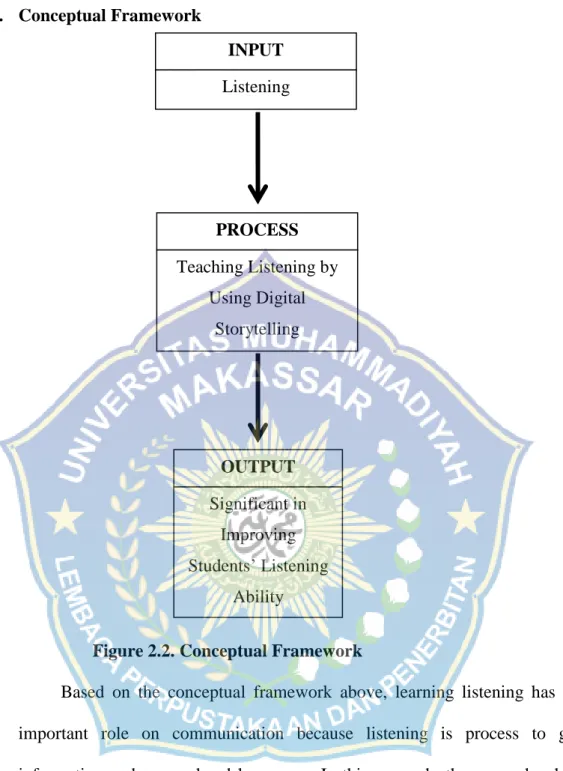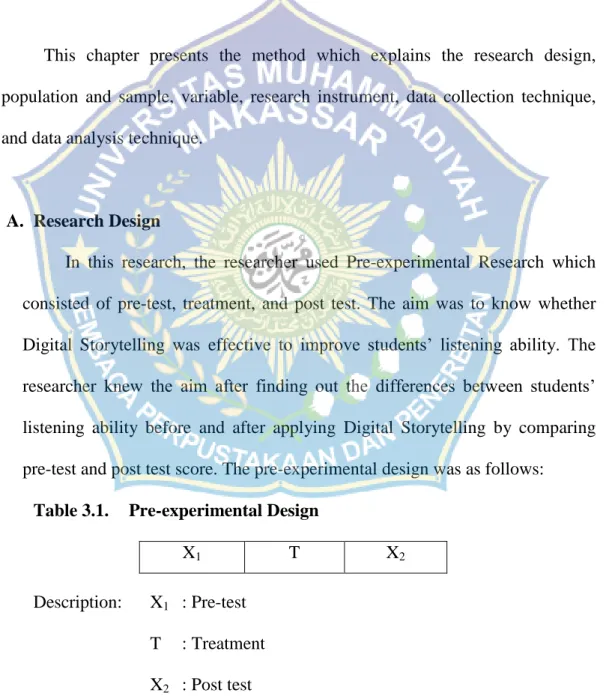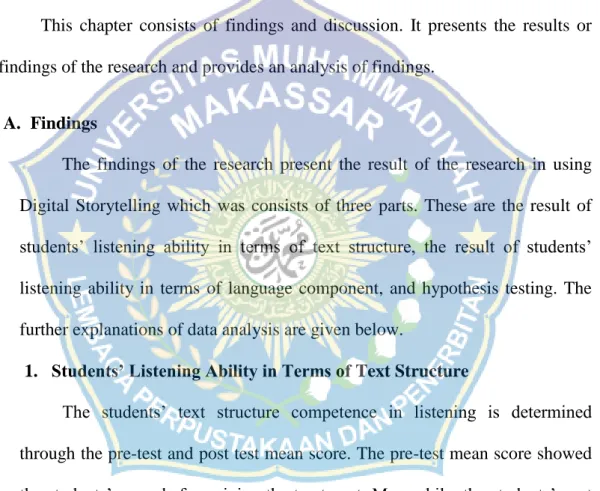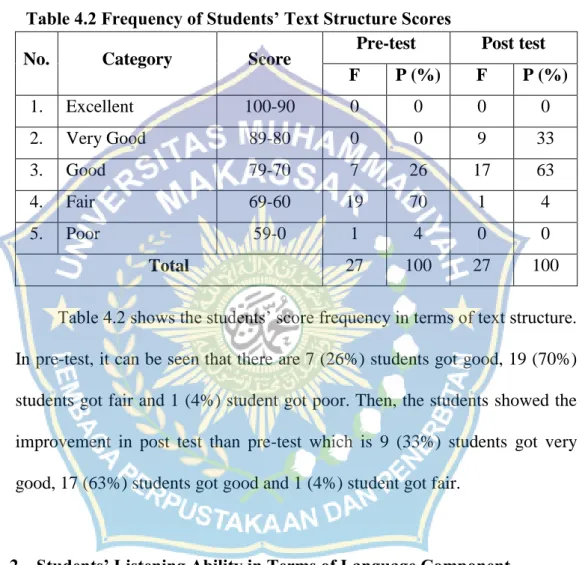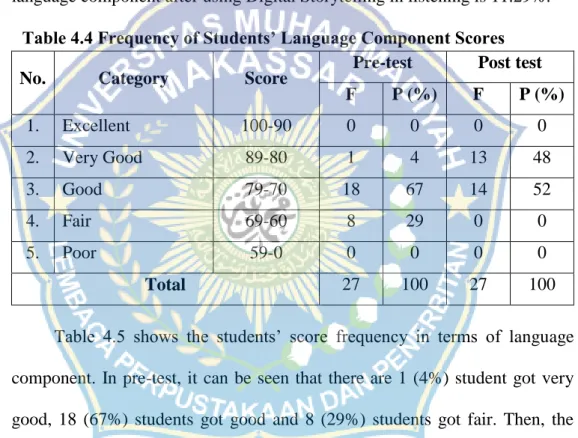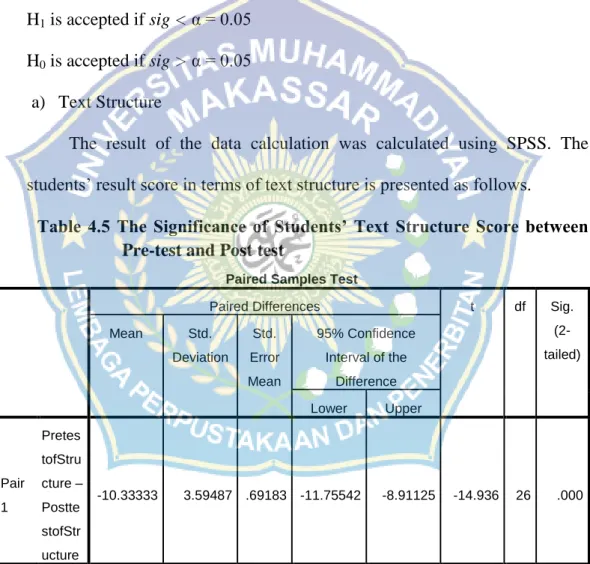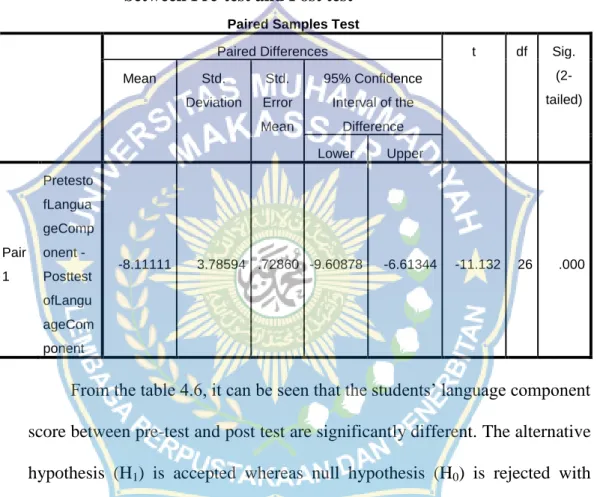Using digital narration to improve students' listening ability (A pre-experimental research in the eighth grade of MTS Syekh Yusuf Sungguminasa in the academic year 2018/2019). This research aimed to improve the listening skill of students in the eighth grade of MTS Syekh Yusuf Sungguminasa using Digital Storytelling. The research findings showed that the change of students before and after using digital storytelling was significantly different.
Artinya terdapat perbedaan yang signifikan kemampuan menyimak siswa sebelum dan sesudah menggunakan digital storytelling. Berdasarkan temuan tersebut, dapat disimpulkan bahwa bercerita digital efektif untuk meningkatkan kemampuan mendengarkan siswa kelas delapan MTS Syekh Yusuf Sungguminasa pada tahun ajaran 2018/2019. Penggunaan Bercerita Digital untuk Meningkatkan Kemampuan Mendengarkan Siswa (Penelitian Pra-Eksperimental di Kelas VIII MT Syekh Yusuf Sungguminasa Tahun Pelajaran 2018/2019).
Penelitian ini bertujuan untuk meningkatkan keterampilan mendengarkan siswa kelas VIII MTs Syekh Yusuf Sungguminasa menggunakan Digital Storytelling. Berdasarkan temuan tersebut, dapat disimpulkan bahwa Digital Storytelling efektif dalam meningkatkan keterampilan mendengarkan siswa kelas VIII di MTs Syekh Yusuf Sungguminasa tahun ajaran 2018/2019.
INTRODUCTION
- Problem Statement
- The Objective of the Research
- The Significance of the Research
- Scope of the Research
Some previous researchers have used digital storytelling in their research to understand the impact of digital storytelling on students' ability. LoBello (2015) used research by introducing digital storytelling after completing questionnaires for baseline interviews and assessments with students. Based on previous researchers and this condition, the researcher believed that digital storytelling can be an alternative way to improve students.
Based on the background of the research, the problem statement was formulated in question form in the following ―Is the use of Digital Storytelling effective in improving students' listening ability at the Eighth Grade of MTs Syekh Yusuf Sungguminasa?‖. The result of the research can provide useful information on how to improve students' listening ability by using Digital Storytelling. It can encourage the teachers to improve teaching and learning process by implementing Digital Storytelling in the class.
It can make students interested in learning English, which helps them improve their listening ability by using Digital Storytelling. The purpose of this research is the use of Digital Storytelling in improving students' listening ability.
REVIEW OF LITERATURE
Concept of Digital Storytelling
Robin (2008) sees the benefits of using digital storytelling in the classroom from both teacher and student perspectives. Lambert in Robin (2008) identifies seven elements of digital storytelling that are key components of effective digital stories. It outlines the essence of the story and the perspective from which the story is told for a particular purpose.
Finally, tempo sustains the attention of the audience by establishing and modifying the rhythm of the story. According to Ornstein (Chalak and Nasr Esfahani, 2012), text structure is the main idea of the text, information organization, as well as the verbal and textual cues that bring unity to the. A subdivision of phonology is phonetics, the study of the speech sounds of human language in general, either from the perspective of their production (articulatory phonetics), their perception (auditory phonetics), or their physical properties (acoustic phonetics).
Morphology is the study of the structure or form of words in a particular language, and of their classification. Syntax is a vast and complex area of language, and almost one-third of the textbook is devoted to the study of English syntax.
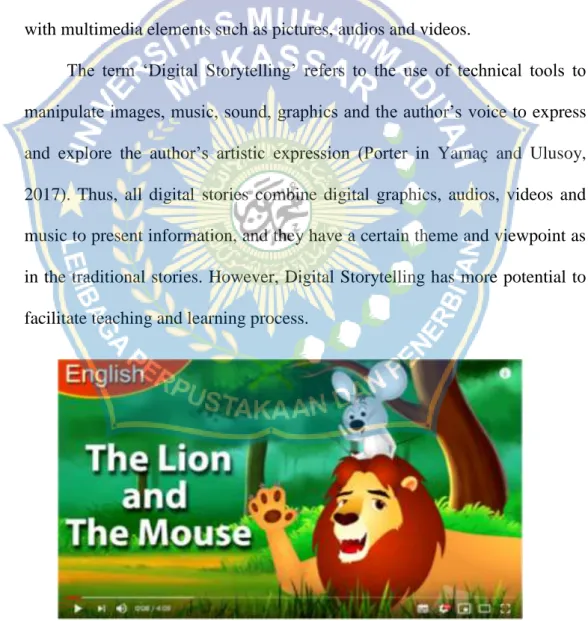
Conceptual Framework
The result that is likely to emerge is that digital storytelling is important in improving students' listening skills, but digital storytelling is not important in improving students' listening skills.
Hypothesis
RESEARCH METHOD
- Population and Sample
- Variable
- Research Instrument
- Data Collection Technique
- Data Analysis Technique
Then, the postal test was done to recognize and discover the listening ability of the students after the implementation of Digital Storytelling. It shows that students' score between pre-test and post-test is significantly different. Students' text structure competence in listening is determined through average pre-test and post-test scores.
The students' language component competence in listening is determined by means of the pre-test and post-test average score. From table 4.5 it can be seen that the students' text structure score differs significantly between pre-test and post-test. From table 4.6 it can be seen that the students' language component score differs significantly between pre-test and post-test.
The mean score of the students before the use of digital storytelling in the pre-test was lower than in the post-test. The result of the post-test showed that the students' score improved higher than the pre-test. The use of digital storytelling is effective in improving students' listening skills in terms of text structure.
The use of Digital Storytelling is effective in improving students' listening skills in the language component. Students' Preferred Activities for English Listening Lessons (A survey conducted among second and fourth semester students of English Department of FKIP Universitas Bengkulu Academic Year 2005/2006). Nobody likes me, I'm so ugly!' The duckling decided to leave the family and go somewhere deep into the forest.
I challenge any animal here to race with me.‖ The foxes and donkeys and frogs and snakes watched in silence. The lion who opened his mouth wide and said: "Sheep, tell me if my mouth smells bad?" The sheep thought the lion wanted an honest answer, so the sheep said: “Yes, Friend.
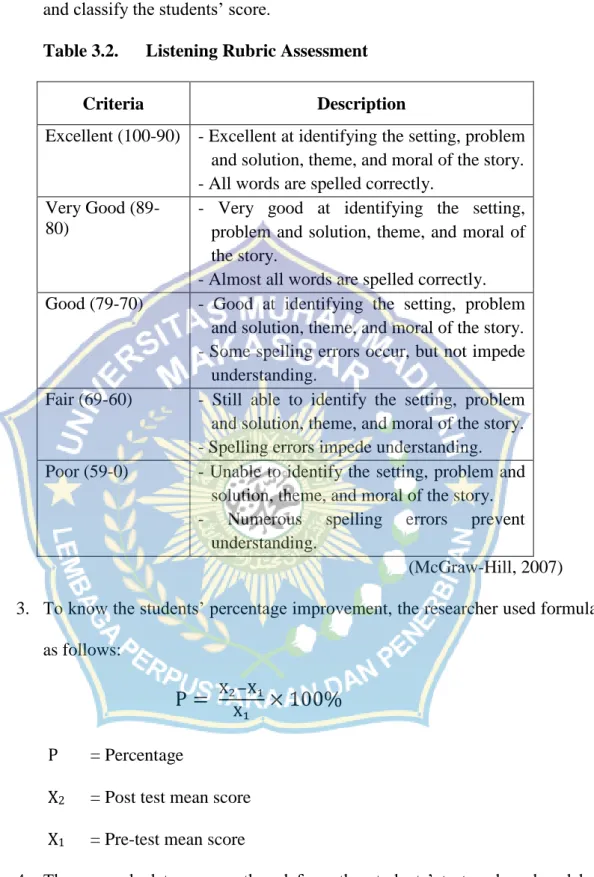
FINDINGS AND DISCUSSION
Discussion
Bertanya tentang unsur kebahasaan (past tense) teks narasi lisan dan tulis, berbentuk fabel pendek dan sederhana sesuai dengan konteks penggunaannya D. Siswa mencari dan mengumpulkan informasi terkait unsur kebahasaan (past tense) yang digunakan dalam fabel adalah terkandung. yang didengarkan bersama. Siswa menuliskan unsur kebahasaan (past tense) yang terdapat dalam fabel dengan melengkapi paragraf-paragraf yang belum selesai.
Pengungkapan unsur kebahasaan (kata keterangan) teks narasi lisan dan tulis, berbentuk fabel pendek dan sederhana sesuai dengan konteks penggunaannya D. Siswa mencari dan mengumpulkan informasi terkait unsur kebahasaan (kata keterangan) yang terkandung dalam fabel yang dimilikinya terdengar dalam kolaborasi. Siswa menuliskan unsur kebahasaan (kata keterangan) yang terdapat dalam fabel dengan melengkapi paragraf yang belum lengkap.
Menanyakan tentang unsur kebahasaan (kata benda) dalam teks narasi lisan dan tulis berbentuk fabel pendek dan sederhana sesuai dengan konteks penggunaannya. Siswa menuliskan unsur kebahasaan (kata benda) yang terdapat dalam fabel dengan mengisi bagian yang belum lengkap. Mengungkapkan unsur kebahasaan (kata sifat) teks narasi lisan dan tulis berbentuk fabel pendek dan sederhana sesuai dengan konteks penggunaannya D.
Dengan melengkapi paragraf yang belum selesai, siswa menuliskan unsur kebahasaan (kata sifat) yang terdapat dalam fabel. Pengungkapan unsur kebahasaan (kata kerja) teks narasi lisan dan tulis, berbentuk fabel pendek dan sederhana sesuai dengan konteks penggunaannya D. Dengan melengkapi paragraf yang belum selesai, siswa menuliskan unsur kebahasaan (kata kerja) yang terkandung dalam fabel.
CONCLUSION AND SUGGESTION
Suggestion
Siswa mencari dan mengumpulkan informasi terkait unsur kebahasaan (kata benda) yang terkandung dalam dongeng yang didengarkannya secara kolaboratif.
Listening Pre-Test
Listening Post Test
The lion began to roar loudly and tried to escape, but the hunters closed the net. I will set you a (7)……….” He climbed onto the trap and bit through the ropes with his sharp teeth.
Lesson Plans 1
Siswa mencari dan mengumpulkan informasi terkait unsur kebahasaan (kata sifat) yang terkandung dalam dongeng yang didengarkannya secara kolaboratif. Siswa mencari dan mengumpulkan informasi terkait unsur kebahasaan (kata kerja) yang terkandung dalam dongeng yang didengarkannya bersama-sama.
Lesson Plans 2
Lesson Plans 3
Lesson Plans 4
Lesson Plans 5
Siswa menyampaikan jawabannya dari materi yang telah dipelajarinya - Siswa menerima tanggapan dari guru dan teman tentang jawabannya. Siswa mengkonfirmasi materi yang telah dipelajari dengan melakukan refleksi terhadap kegiatan pembelajaran dan manfaatnya - Guru memberikan umpan balik terhadap proses dan hasil pembelajaran - Guru menyampaikan informasi tentang rencana kegiatan pembelajaran.
Lesson Plans 6
When the lion heard the answer, he roared furiously and immediately attacked and killed the wolf. So he coughed and cleared his throat again and again and then said, “Oh Dear Friend, for the last few days I have had a very bad cold.
The Students‘ Row of Pre-test
The Students‘ Row of Post test
The Students‘ Classifications
The Students‘ Mean Score
The Percentages of Students‘ Improvement
Frequencies Variables
